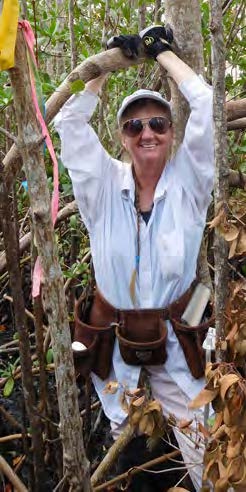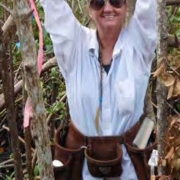Wildlife Superheroes
by Joanna Fitzgerald and Kathy Worley

Joanna Fitzgerald
When Joanna Fitzgerald and Kathy Worley measure and celebrate milestones, it’s likely by releasing a rehabilitated animal to the wild or successful planting of mangroves.
This year has also marked a milestone for each of them. With 25 years each as champions of the environment at the Conservancy of Southwest Florida, the gifts of their dedication to the area’s flora and fauna is immeasurable.
Fitzgerald is director of the Conservancy’s von Arx Wildlife Hospital. She oversees the rehabilitation and treatment of approximately 4,000 injured, orphaned and sick native wildlife every year.
Worley is responsible for directing and managing organizational science research, programs and staff as the Conservancy’s Director of Environmental Science.
Fitzgerald started at the Conservancy as an intern in 1994 and was named director of the wildlife hospital in 1999. As director, she runs the hospital, which is open 365 days a year from 8 a.m. to 8 p.m., but also oversees the treatment of the admitted “patients,” particularly this year with only half of the usual staff and volunteers available because of the pandemic.
The Conservancy has been caring for injured wildlife since 1979. Even so, she finds time (since 2009!) to write a weekly article for area newspapers, medium.com and conservancy.org highlighting the hospital’s injured wildlife admissions, causes of injuries and ways people can prevent injuries to wildlife – more than 500 articles in 11 years!
The stories and pictures she shares are often heartbreaking, sometimes inspiring, but always passionate — sea birds such as a royal tern impaled with fishing hooks, a tiny baby gray squirrel injured by a chainsaw as a nest tree was trimmed, a majestic barred owl that was hit by a vehicle, Florida softshell turtles that fell into pools, an anhinga that was dangling by fishing line from a tree over Lantern Lake in Port Royal.

Kathy Worley ‘hanging out’ with mangroves.
In a recent week, for example, 66 injured birds, mammals and reptiles were admitted for injuries and 26 were released. Some of the animals don’t survive their injuries, like the anhinga.
The awareness of the work done at the von Arx Wildlife Hospital is critical because it receives no government funding for operating expenses and is primarily supported by donations.
“I am so grateful that we live in a place where people are so incredibly passionate about our wildlife,” Fitzgerald says.
In addition to her internship, Fitzgerald’s foundation was a degree in zoology from the University of Wisconsin at Madison, an internship at zoos in Wisconsin and Illinois, volunteering for the International Crane Foundation and field research on Wood Thrush nesting success for the National Park Service in the Great Smoky Mountains.
Her passion remains making a difference for area wildlife and teaching the humans who share the planet how to have less impact.
Worley has also spent her career at the Conservancy rescuing the environment. Focusing on mangroves, water quality and sea turtle research, she is also passionate about vulnerable plants and animals and how humans impact them.
The Conservancy of Southwest Florida Science Department works across a wide range of projects, both public and private, to support the organization’s mission to protect Southwest Florida’s water, land, wildlife and future.
After getting her undergraduate degree in biology at Colorado State University, she got a master’s degree at Florida International University, where her thesis was on why mangrove forests die. She started as an environmental specialist at the Conservancy in 1995, where she continues to study why mangroves die off near developments, the impact of hurricanes on mangrove systems and the long-term recovery and success of mangrove restoration projects throughout Southwest Florida.
More than 50% of the world’s mangrove forest have been destroyed, with most losses attributable to human activities. Mangroves help stabilize Florida’s coastline, absorbing storm surge and preventing erosion, filtering sediment to protect coral reefs and seagrass meadows and providing essential habitat for thousands of species. Conservancy studies have included one of the longest continual mangrove monitoring programs in Florida at Clam Bay, which started in 1999 and seeks to monitor the health of the system, which is under continual stress from hydrologic alteration, natural weather stressors and human impacts including storm water runoff and dredging.
A four-year project involved restoring mangrove islands in Pine Island Sound following the impact of Hurricane Charley. Worley’s work to ensure water quality includes research, incorporating laboratory and field data analysis. She was instrumental in the creation of the Shotwell-Wavering Filter Marsh in 2011, a natural filtration system to clean drainage water from the Conservancy’s campus before releasing it to the Gordon River and Naples Bay.
She supports the Sea Turtle Monitoring Project at the Conservancy, which has been underway on Keewaydin Island since 1982, making it one of the longest running sea turtle monitoring/research projects in the nation. With her expertise, she has co-authored papers and technical reports on mangrove ecology, sea turtles, water quality and ecotoxicological reports evaluating hazards to wildlife.
“Long-term studies and continued field and laboratory work, along with education and advocacy are critical in being good stewards of our environment,” Worley says. “I’m honored to be able to do my part.”
While 25 years is a milestone to be celebrated, it’s the work of these two environmental champions that is the true cause of celebration. With every native animal released, every python captured, and each mangrove restored, we recognize their role in protecting Southwest Florida’s water, land, wildlife and future for generations to come.




Leave a Reply
Want to join the discussion?Feel free to contribute!